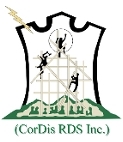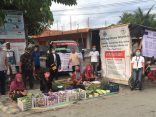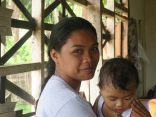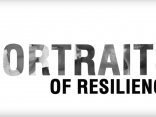In photo: Mayet and the rest of ACCORD are currently working with Baclaran Church to develop an earthquake contingency plan.
Surprised by the sudden vigorous shaking and loud cracking of the glass window panes, Mayet and her officemates bolted out of the their office and into the street. This happened exactly 25 years ago, on the 16th of July 1990, when the 7.8 magnitude Luzon Earthquake hit the Philippines. This was her first earthquake disaster experience, which also became her first humanitarian assistance assignment.
In photo: Mayet and the rest of ACCORD are currently working with Baclaran Church to develop an earthquake contingency plan.
Surprised by the sudden vigorous shaking and loud cracking of the glass window panes, Mayet and her officemates bolted out of the their office and into the street. They quickly ran out of the building towards the open street while being gripped with fear and panic. This happened exactly 25 years ago, on the 16th of July 1990, when the 7.8 magnitude Luzon Earthquake hit the Philippines. This was her first earthquake disaster experience, which also became her first humanitarian assistance assignment.
Marieta Lupig-Alcid was among the first batch of staff in the Citizens Disaster Response Center (CDRC), a local disaster response organization in the Philippines that pioneered community-based preparedness. CDRC was inspired by the hard-won lessons and creativity of the rural masses during their experiences with disasters.
Mayet and her six officemates started to monitor the situation on the television and radio to get the latest updates on the impact of the earthquake. Ranking as one of the 5 deadliest natural disasters in recent Philippine history, the “killer earthquake” claimed the lives of 1,621 people, mainly from Central Luzon and Cordillera Region. It also led to the destruction of many buildings and other infrastructures.
She also recalled that there were very few actors in humanitarian response back then. They coordinated with other relief and development organizations, both local and international, especially those under the Inter-agency Network for Disaster Response (IANDR), such as the Philippine Business for Social Progress (PBSP), Philippine Rural Reconstruction Movement (PRRM), Adventist Development & Relief Agency (ADRA), and others. Many individuals and organizations, even those with few resources, exerted great efforts to provide help and assistance. These included union federations such as the Kilusang Mayo Uno that delivered assistance to union members under their federation and to other affected people.
Mayet participated in rapid assessment and relief delivery missions in Cabanatuan, Nueva Ecija and Aringay, La Union. She was tasked to stay, without any companion, in the field to continue the assessment, monitoring, and the coordination of relief assistance. A church in Aringay provided her with a modest accommodation to continue her work. She planned to head for Baguio City to conduct further investigation but the roads where impassable to vehicles. People would have to walk on foot to be able to go up to or come down from Baguio.
She remember breaking into tears, crying out of fear and anxiety because she was new and clueless on how to accomplish her mission. A month earlier, she completed a 9-day disaster management course with the other CDRC staff and its regional partners, but she still thought that this was not enough to complete the assigned tasks. Eventually, they were able to accomplish their goals in providing emergency food assistance in partnership with local NGOs, such as the Montañosa Relief and Rehabilitation Services Foundation (now renamed into Cordillera Disaster Response and Development Services), and of course, with help from local people’s organizations.

In photo: Mayet with PHIVOLCS Director Renato U. Solidum. ACCORD works with PHIVOLCS to ensure that its earthquake preparedness plans are sound.
Now a seasoned humanitarian worker herself, Mayet heads the Assistance and Cooperation for Community Resilience and Development (ACCORD), a recently formed organization that continues to uphold community-based work and promotes a rights-based approach to humanitarian assistance. ACCORD is one of the pioneer organizations in the Philippines that promote the integrated of disaster risk reduction, climate change adaptation, and ecosystems management and restoration.
According to Mayet, there were many new approaches today that were not available or popular during their time. Science and technology has deepened its understanding of phenomena and has improved its approaches in reducing the risks of an earthquake disaster. Since then, lessons were carefully drawn from many earthquake experiences and now widely and systematically applied to development of policies, technologies, as well as in safety and response practices. For example, the “drop, cover, and hold” earthquake safety routine, which is now used in many schools and workplaces, was not popular back in 1990. Also, back then, humanitarian response standards did not exist. These standards developed by The Sphere Project1.
ACCORD also recognizes the importance of upholding and protecting human dignity in times of crisis. It subscribes to these minimum standards and applies it carefully, considering the specific context of the emergency situation, to ensure that traditional values are respected as well. Such was the approach adopted by the ACCORD’s project team in its Bohol Earthquake response in 2013.
ACCORD is currently participating in the Metro Manila Shake Drill by raising awareness through public information sessions and in helping communities, churches, office and residential buildings to develop preparedness plans and conduct drills. Mayet urges all her fellow humanitarian workers to continue in raising awareness, and in helping people, especially the most vulnerable and at-risk groups, to be empowered and resilient against disasters. She also commends the local non-government organizations actively assisting other organizations in helping them prepare for earthquake disasters.
Indeed, 25 years have passed since the July 1990 Luzon Earthquake disaster, and there has been significant changes and improvements in the awareness and approaches in reducing the risk of disasters. However, the challenge of building community resilience rested on transformation of the main source of social vulnerability that has continued to plague the Philippine society: poverty. The poor have the least capacity to protect themselves and to recover from disasters.
Nevertheless, Mayet, in her long career of being a humanitarian worker, shares that the most important principle that she can share is that a humanitarian worker must continue to have faith in the strengths and capacity of the people, that through their collective effort and solidarity to assert their rights to safety and to a life with dignity, achieving resilience can be a reality.
1 The Sphere Project was initiated in 1997 by NGOs and the Red Cross movement to develop a set of minimum standards for humanitarian assistance




